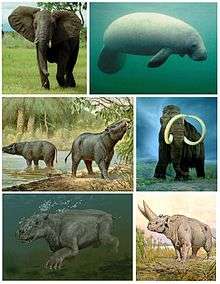Tethytheria
Tethytheria is a clade of mammals that includes the sirenians and proboscideans, as well as the extinct order Embrithopoda.[1]
| Tethytheria | |
|---|---|
 | |
| Top: African elephant, Caribbean manatee; middle: Moeritherium, woolly mammoth; bottom: Paleoparadoxia, Arsinoitherium | |
| Scientific classification | |
| Kingdom: | Animalia |
| Phylum: | Chordata |
| Class: | Mammalia |
| Clade: | Paenungulata |
| Clade: | Tethytheria McKenna 1975 |
| Subclades and Orders | |
| |
Though there is strong anatomical and molecular support for the monophyly of Tethytheria, the interrelationships between the included taxa remain disputed. The tethytheres are united by several characters, including anteriorly facing orbits and more or less bilophodont cheek teeth (double transverse ridges on the crowns of the teeth). Proboscidea and Sirenia are linked together based on auditory characters in their petrosal bones, but this link may be a homoplasy. Desmostylians, traditionally considered tethytheres, have been tentatively assigned to Perissodactyla, along with the Early Eocene family Anthracobunidae, which was considered a sister group to Tethytheria.[2][3]
Tethytheria is thought to have evolved from primitive hoofed mammals ("condylarths") along the shores of the ancient Tethys Ocean.
Systematics
Cladogram modified from Rose 2006 and Cooper et al 2014.[4]
| Afrotheria |
| ||||||||||||||||||||||||
Classification
Classification modified from Rose 2006.[2]
- Suborder Tethytheria
- Infraorder †Embrithopoda
- †Phenacolophidae
- †Arsinoitheriidae
- Infraorder Sirenia
- †Prorastomidae
- †Protosirenidae (Dugongidae?)
- Dugongidae
- Trichechidae
- Infraorder Proboscidea
- †Phosphatheriidae (Numidotheriidae?)
- †Numidotheriidae
- †Moeritheriidae
- †Barytheriidae
- †Deinotheriidae
- †Palaeomastodontidae
- †Phiomiidae
- †Hemimastodontidae
- †Mammutidae
- †Gomphotheriidae
- Elephantidae
- Infraorder †Embrithopoda
Notes
- Tethytheria in the Paleobiology Database. Retrieved April 2013.
- Rose 2006, pp. 242–3
- Cooper, L. N.; Seiffert, E. R.; Clementz, M.; Madar, S. I.; Bajpai, S.; Hussain, S. T.; Thewissen, J. G. M. (2014-10-08). "Anthracobunids from the Middle Eocene of India and Pakistan Are Stem Perissodactyls". PLoS ONE. 9 (10): e109232. Bibcode:2014PLoSO...9j9232C. doi:10.1371/journal.pone.0109232. PMC 4189980. PMID 25295875.CS1 maint: ref=harv (link)
- Rose 2006, p. 213
References
- McKenna, M.C. (1975). "Toward a phylogenetic classification of the Mammalia". In Luckett, W.P.; Szalay, F.S. (eds.). Phylogeny of the primates: a multidisciplinary approach (Proceedings of WennerGren Symposium no. 61, Burg Wartenstein, Austria, July 6–14, 1974. New York: Plenum. pp. 21–46. doi:10.1007/978-1-4684-2166-8_2. ISBN 978-1-4684-2168-2.CS1 maint: ref=harv (link)
- Rose, Kenneth David (2006). The beginning of the age of mammals. Baltimore: JHU Press. ISBN 0801884721.CS1 maint: ref=harv (link)